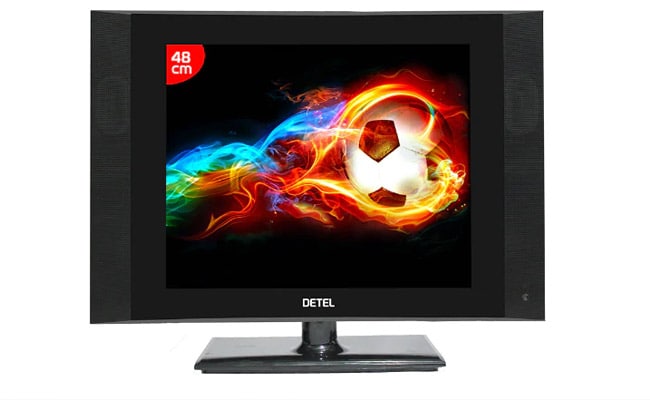350 mins means super/ultra bright panel...he he heJust saw the specs for Motorola TV. They have mentioned a brightness of 350 nits and static contrast of 1300:1. So yeah pretty disappointing
You are using an out of date browser. It may not display this or other websites correctly.
You should upgrade or use an alternative browser.
You should upgrade or use an alternative browser.
Upcoming launches of tv
- Thread starter gappa
- Start date
There are 4 options for motion flow including off option....seems good provided we get an opportunity to demo and decideNo mention of local dimming or info about the type of panel, brightness and contrast ratio. HDR without FALD is kinda useless. Blacks become greyish. MEMC will add soap opera effect without custom user options, which aren't present in usually cheap softwares.
One more in line.everybody want to incash India.

 www.bgr.in
www.bgr.in

जर्मनी बेस्ड Telefunken ने इंडियन मार्केट में पेश किए 7 नए LED TVs, कीमत 7,999 रुपये से शुरू
कंपनी ने जो रेगुलर LED TV को पेश किया है उनकी शुरुआती कीमत 7,999 रुपये है। टॉप ऑफ द लाइन स्मार्ट LED TV को 4K Ultra HD रिजॉल्यूशन के साथ पेश किया गया है जिसमें 65इंच का पैनल दिया गया है। इस टीवी की कीमत 54,999 रुपये है। कंपनी ने स्मार्ट टीवी सीरीज को चार अलग-अलग साइज में पेश किया है। इनमें...
Srinivasa Rao
Active Member
MRP is 149000/-, needs to see for how much it retails apart from festival discounts.Is this realView attachment 39171
bitanshudas
Active Member
if MRP is 1.5 , it should sell around 80k-100k. The price makes sense since Peter Lau had already mentioned that they are competing with Samsung, LG and Sony and not VU and Xiaomi. Also the price means it should be a good TV rather than sub standard units launched by Motorola and Xiaomi.Is this realView attachment 39171
It is too early to throw the weapon are they afraid

 www.bgr.in
www.bgr.in

Samsung Festive Offers: A look at top deals on QLED TV, home appliances
Check out top offers from Samsung during festive offers valid till October 30, 2019. Customers stand to get Galaxy S10 or Galaxy A50 with purchase of QLED TVs.
Enkay78
Well-Known Member
Hope this also helps in making the prices 'conducive'

 www.ndtv.com
www.ndtv.com

LED/LCD Televisions Likely To Get Cheaper As Government Scraps Import Duty
In June 2017, the government had imposed a custom duty of 5 per cent on import of such panels which are used in making LED and LCD TVs.
bitanshudas
Active Member
It depends on which TV you compare them with. Equipping a TV with Dolby Vision and HDR isn't enough, you have to provide the hardware to make the difference. I also am currently using an Iffalcon K2A 55" TV which is great for its price point but when I compare it with higher-end models, the difference is so obvious. As you said you are in the market for a cheap TV and certainly the price point for the mentioned TVs are attractive but that's about it. I know my iffalcon supports HDR but I hardly notice anything special when I play HDR content, be it on Netflix or PS4. As I mentioned, Peter Lau said that he wants to compete with the big players of TV and not the mid players and hence for reference, we will compare it with a high-end model rather than a Xiaomi or Motorola.Care to elaborate? I am in the market to buy a cheap 55" or 65" tv and upcoming Mi 65" looks good to me. My main requirement is good(not the best) picture quality in full hd and 4k. Nowadays only some news channels are telecasting in SD, rest all is minimum full hd. I think these cheap TVs are poor in upscaling SD but I tested a LG UK7300 and it was horrible in SD and induced sea sickness while watching full hd star plus channels.
I don't care for smartness(I will be using a firestick or a pc) or booming sound(will be using my 2.0 stereo setup).
HDR without good local dimming is pointless. Just a marketing blurb. You'll get better picture by sticking to SDR. HDR without good local dimming on IPS panels is even worse.
Like bitanshudas, I had a short stint with an OLED just recently, and even though the software sucked on that TV, the panel (apart from flashing bug) was just as good as any 2019 OLED, and there's a big big difference compared to the Iffalcon K2A.
Can't wait to get my hands on a C9, or if Panasonic launches, then GZ950! If you can save up for them, do so. Even B9 would be leagues ahead of these cheap TVs.
Like bitanshudas, I had a short stint with an OLED just recently, and even though the software sucked on that TV, the panel (apart from flashing bug) was just as good as any 2019 OLED, and there's a big big difference compared to the Iffalcon K2A.
Can't wait to get my hands on a C9, or if Panasonic launches, then GZ950! If you can save up for them, do so. Even B9 would be leagues ahead of these cheap TVs.
bitanshudas
Active Member
As I said for their price range they are good TVs but in the line of LED TVs they are sub standard. Its all about the point of reference.
hrish88
Active Member
I think if oneplus launches the tv over 1 lac selling price then it will be a tough sell.becuse at diwali all the good tvs samsung Q6,LG B9,Sony x95G etc will be available around 1.1 to 1.25.if we go by last year trends.
bitanshudas
Active Member
I think they know that. I think the price will be higher than Mid Range brands but lower than the high end spectrum.I think if oneplus launches the tv over 1 lac selling price then it will be a tough sell.becuse at diwali all the good tvs samsung Q6,LG B9,Sony x95G etc will be available around 1.1 to 1.25.if we go by last year trends.
bitanshudas
Active Member
Not all shops charge 2% extra for credit card payment. I rarely have paid the 2% extra charge.This brings up a point. Recently I bought a washing machine which I bought with an HDFC credit card giving me "15% cashback." Now if I had bought in cash this machine would have costed me 15% more. I am not able to understand the logic behind this. Shopkeeper told me that companies are under pressure to promote cashless. In the name of cashless our govt is forcing us to fill the pockets of banks and MNCs like Mastercard & Visa. Every retail shopkeeper charges 2% extra for using credit card. So I paid 2% extra to shopkeeper and got 15% cashback. Now these convoluted schemes will only end up making products costlier for consumers. It also proves that in India big companies keep very hefty margins so as to offer such huge discounts.
bitanshudas
Active Member
Thats true. I hardly see any limitations when watching casual TV but there are some contents which really suffer. For eg: I watched the battle of winterfell of GOT early in the morning and no matter how dark I made the room or maxed out my TV, it was barely watchable. But I watched the same thing on X900F and realised that premium price matters! Even watching live football matches (tata sky HD content) you can see the difference between a lower end model and higher end model. Once you see the limitations of your set, you cant unsee it !Staying on this discussion, I have been visiting stores and only thing that differentiates TVs like TCL and VU from premium brands is brightness. So if we compare TVs in the store, we tend to like premium branded tvs better. Now in the stores all these TVs are in demo mode and we will most certainly lower the brightness in our homes. . I feel that at home this brightness wont matter for SDR material. HDR will be another story. Am I correct in assuming this? I dont think my 40" Infocus tv is lacking in brightness.
bitanshudas
Active Member
Also you can easily see the difference between FALD and ELED. Micro dimming feature is hardly noticable in iffalcon. But Local dimming certainly works on a Sony.Staying on this discussion, I have been visiting stores and only thing that differentiates TVs like TCL and VU from premium brands is brightness. So if we compare TVs in the store, we tend to like premium branded tvs better. Now in the stores all these TVs are in demo mode and we will most certainly lower the brightness in our homes. . I feel that at home this brightness wont matter for SDR material. HDR will be another story. Am I correct in assuming this? I dont think my 40" Infocus tv is lacking in brightness.
This is illegal. As per RBI guideline no merchant can charge you the transaction chargesThis brings up a point. Recently I bought a washing machine which I bought with an HDFC credit card giving me "15% cashback." Now if I had bought in cash this machine would have costed me 15% more. I am not able to understand the logic behind this. Shopkeeper told me that companies are under pressure to promote cashless. In the name of cashless our govt is forcing us to fill the pockets of banks and MNCs like Mastercard & Visa. Every retail shopkeeper charges 2% extra for using credit card. So I paid 2% extra to shopkeeper and got 15% cashback. Now these convoluted schemes will only end up making products costlier for consumers. It also proves that in India big companies keep very hefty margins so as to offer such huge discounts.
Companies tie up with banks to promote sales.This brings up a point. Recently I bought a washing machine which I bought with an HDFC credit card giving me "15% cashback." Now if I had bought in cash this machine would have costed me 15% more. I am not able to understand the logic behind this. Shopkeeper told me that companies are under pressure to promote cashless. In the name of cashless our govt is forcing us to fill the pockets of banks and MNCs like Mastercard & Visa. Every retail shopkeeper charges 2% extra for using credit card. So I paid 2% extra to shopkeeper and got 15% cashback. Now these convoluted schemes will only end up making products costlier for consumers. It also proves that in India big companies keep very hefty margins so as to offer such huge discounts.
The bank is not giving you the cashback, it is the company that pays the bank, which eventually comes to you.
Company makes it attractive to buy via these schemes.
Banks are hopeful that some will retain a balance for a few months or so.
What's wrong with the business model? It has nothing to do with cashless.
Paying by debit card is cashless; and no, you don't get the deal if it is debit card transaction.
The shopkeeper is plain BS'ing on cashless as a reason.
As for the 2% charge, it is ridiculous. Something is not right here.
Even my vegetable vendor absorbs this, why would a white goods vendor charge you?
Cheers,
Raghu
Wharfedale Linton Heritage Speakers in Walnut finish at a Special Offer Price. BUY now before the price increase.
Similar threads
- Replies
- 0
- Views
- 2K


